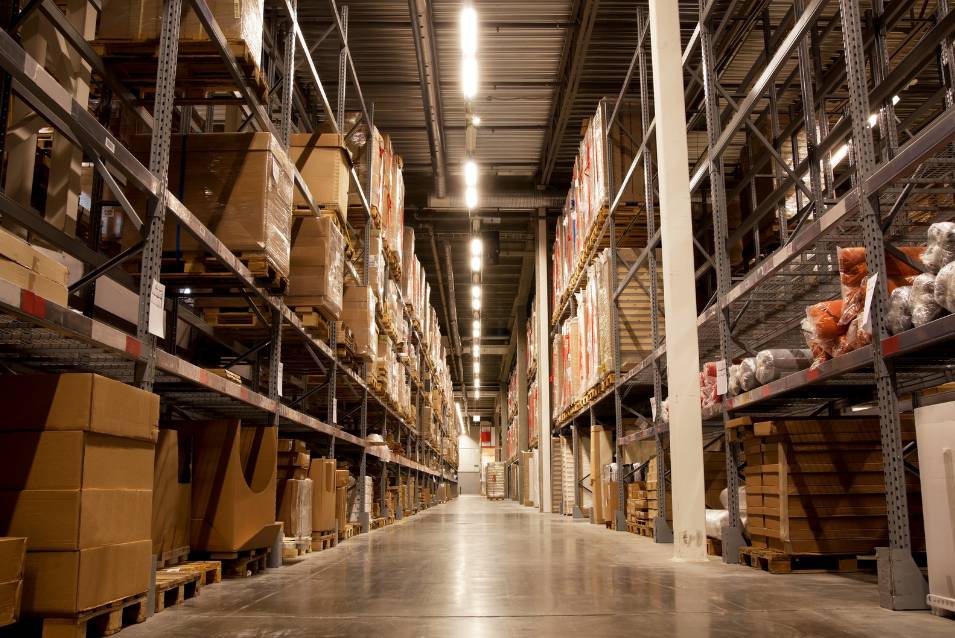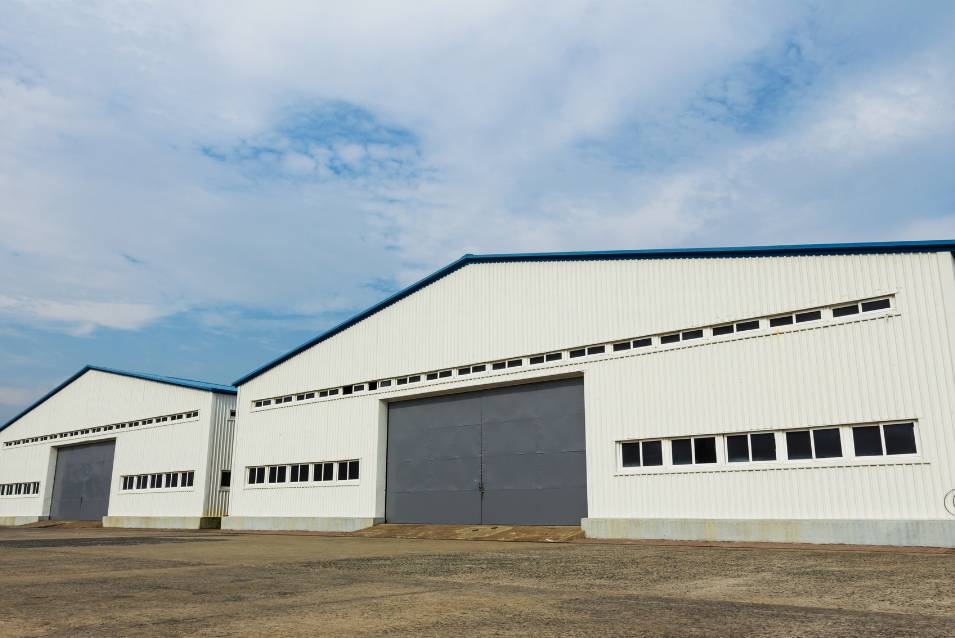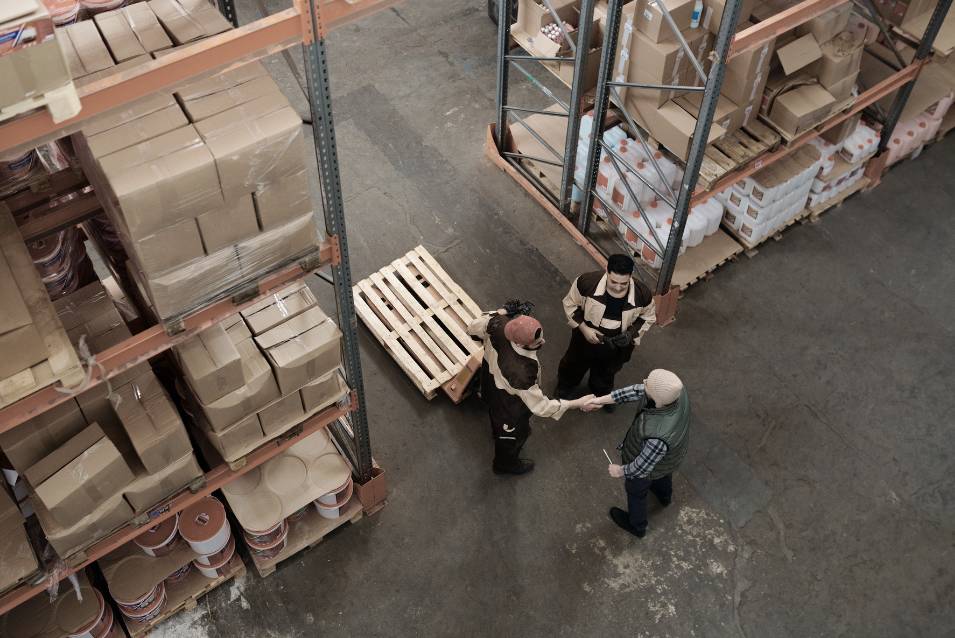In supply chain management, the efficiency of a warehouse storage system stands as a cornerstone of success, dictating the smooth flow of goods from production to distribution. A strategically constructed inventory storage system will streamline the internal logistics of your business, ensuring swift and accurate retrieval of goods. Moreover, in an era where customer experience can make or break your business, a well-orchestrated storage system plays a pivotal role in meeting consumer demands promptly and with precision.

What Is a Warehouse Storage System?
A warehouse storage system encompasses a complex array of methodologies, technologies, and physical infrastructure designed to facilitate the systematic storage, organization, and retrieval of goods within a warehouse or distribution center. By integrating different components, it optimizes space, enhances inventory management, and boosts overall operational efficiency. There are many types of warehouse storage solutions to choose from, and deciding on the right one for your organization can improve your business in several ways:
1. Optimized Space Utilization
A well-designed storage system maximizes the use of available space, allowing for efficient storage of goods without unnecessary clutter or wastage.
2. Streamlined Inventory Management
Effective inventory storage systems enable systematic inventory tracking, ensuring accurate stock counts and timely refilling, which prevents overstocking and stockouts.
3. Enhanced Operational Efficiency
A good storage system facilitates smooth and swift movement of goods, reducing the time taken for picking, packing, and shipping, thus enhancing overall operational productivity.
4. Reduced Risk of Damage and Loss
A proper commercial storage solution safeguards products from damage or misplacement, minimizing the risk of financial losses due to damaged goods or inventory discrepancies.
5. Improved Customer Satisfaction
Well-organized warehouse storage systems allow for prompt order fulfillment, leading to timely and accurate deliveries, which, in turn, enhances customer satisfaction and builds trust in the business’s reliability.
6. Ensured Personnel Safety
An organized and safe storage system reduces the likelihood of workplace accidents and injuries, creating a secure environment for warehouse personnel to operate efficiently and effectively.

Factors to Consider
Seeing that there are many different warehousing storage options available, it’s important to evaluate several key elements in order to choose what best aligns with your business’s specific needs. This will enable smooth operations and maximize the potential of your storage space. There are several important factors to consider:
1. Warehouse Layout and Space Constraints
Evaluate the dimensions of your warehouse, including the available warehouse storage facilities, floor space, and ceiling height, to select a racking system that optimizes vertical space and efficiently utilizes the available storage area.
2. Storage Requirements and Inventory Characteristics
Assess the nature of your inventory, including its size, weight, and storage requirements, to determine the most suitable system that can accommodate your specific storage needs.
3. Pallet Type and Size
Analyze the types and sizes of pallets used for storing your inventory to choose a storage system that can effectively accommodate and secure the specific pallet types utilized in your operations.
4. Number of SKUs Stored in Each Rack
Consider the diversity and quantity of stock-keeping units (SKUs) to be stored within each rack to determine the most efficient and organized arrangement for easy accessibility and inventory management.
5. Product Shelf Life
Factor in the shelf life and perishability of your products to choose a system that supports proper storage conditions and facilitates efficient stock rotation based on the first-in, first-out (FIFO) or last-in, first-out (LIFO) principles as needed.
6. Fork Truck Type and Lift Height
Take into account the type and capabilities of the fork trucks utilized in your warehouse, along with their lifting height capacities, to ensure compatibility with the chosen storage system and to facilitate seamless material handling operations within the warehouse.
7. Accessibility and Retrieval Frequency
Analyze the frequency of inventory retrieval and consider the ease of accessibility required for different products to ensure a smooth and efficient workflow within the warehouse.
8. Scalability and Flexibility
Anticipate future growth and changes in inventory volume, and opt for warehouse storage solutions that offer scalability and adaptability to accommodate potential expansions or modifications in your storage requirements.
9. Cost-Effectiveness and Return on Investment (ROI)
Factor in the initial investment cost, maintenance expenses, and the long-term benefits of each storage system to determine the most cost-effective option that provides a favorable return on investment over its lifespan.

Types of Warehouse Storage Systems
1. Static Shelving
How It Works: Static shelving systems consist of stationary shelves that are accessible manually.
Pros:
- Cost-effective option is suitable for businesses with limited budgets and space constraints.
- Easy access to stored items, facilitating quick retrieval and restocking processes.
- Customizable configurations to accommodate various products and warehouse layouts.
Cons:
- Limited storage capacity, which may be insufficient for businesses with extensive inventories or bulkier items.
- Manual handling requirements can lead to increased labor and time costs for larger-scale operations.
- May not be suitable for high-density storage needs, potentially resulting in underutilized warehouse space.
2. Mobile Shelving
How It Works: Mobile shelving systems are equipped with movable shelves that can be compacted together to maximize storage space.
Pros:
- Maximizes storage capacity by eliminating the need for permanent aisles between shelves.
- Enhances space efficiency, making it an ideal choice for warehouses with limited floor space.
- Improves organization and accessibility, allowing for easy retrieval and restocking of items.
Cons:
- Higher initial investment compared to static shelving, making it more suitable for businesses with higher storage demands.
- Requires regular maintenance to ensure smooth operation of the moving components.
- Potential limitations on the weight capacity of individual shelves, restricting the storage of exceptionally heavy items.
3. Carton Flow Racks
How It Works: Carton flow racks are designed with slightly inclined shelves equipped with roller tracks or wheel beds, allowing cartons and boxes to glide smoothly from the loading end to the picking end through the force of gravity. This design promotes first-in, first-out (FIFO) inventory management, ensuring efficient stock rotation.
Pros:
- Maximizes storage capacity by eliminating the need for permanent aisles between shelves.
- Enhances space efficiency, making it an ideal choice for warehouses with limited floor space.
- Improves organization and accessibility, allowing for easy retrieval and restocking of items.
Cons:
- Limited suitability for storing irregularly shaped or oversized items, as the design is more suitable for uniform cartons or boxes.
- Initial investment costs may be relatively higher compared to traditional shelving systems, particularly for businesses with smaller storage requirements.
- Requires regular maintenance of the roller tracks or wheel beds to ensure smooth carton flow and prevent operational disruptions.
4. Wired Partitions
How It Works: Wired partitions, also known as wire mesh partitions, are modular partition systems constructed from interconnected wire mesh panels. These partitions are commonly used to create secure enclosures within warehouse spaces, providing secure areas for storing items, while also ensuring visibility and ventilation.
Pros:
- Enhances security by creating designated enclosures for high-value or sensitive items, protecting them from unauthorized access or theft.
- Offers visibility and ventilation, allowing for easy monitoring of stored items and ensuring proper airflow within the warehouse.
- Easily customizable and adjustable to accommodate various warehouse layouts and storage requirements.
Cons:
- Limited suitability for storing bulkier or larger items that may not fit within the confines of the wired partitions, potentially leading to space constraints.
- May require additional security measures, such as locks or access control systems, to reinforce the protection of valuable inventory.
- Initial installation costs may be relatively higher compared to standard shelving systems, particularly for businesses with limited budget allocations for security infrastructure.
5. Multi-Tier Racking
How It Works: Multi-tier racking involves the use of multiple levels of racking, creating a multi-level storage structure within the warehouse. This system maximizes vertical space utilization, and it is commonly used for businesses requiring extensive storage capacities within limited floor spaces.
Pros:
- Optimizes vertical storage space, enabling businesses to accommodate a large volume of inventory without expanding the warehouse’s footprint.
- Facilitates organized storage and retrieval processes, enhancing overall operational efficiency and reducing picking and packing times.
- Offers flexibility in design and configuration, allowing for tailored solutions to meet specific storage and accessibility requirements.
Cons:
- Higher initial investment costs compared to traditional shelving systems, particularly for businesses with limited budget allocations for warehouse infrastructure.
- Requires careful consideration of load capacities and weight distribution across different levels to ensure structural integrity and safety.
- Potential constraints on accessibility and maneuverability for certain types of forklifts or material handling equipment, requiring careful planning for efficient material flow between levels.
6. Mezzanine Storage Systems
How It Works: Mezzanine storage systems involve the construction of an intermediate floor or platform between the main levels of a warehouse, effectively creating additional storage space without the need for expanding the warehouse’s footprint. These elevated platforms can be used for various purposes, including storage, office space, or additional working areas.
Pros:
- Maximizes vertical space utilization, creating additional storage capacity without requiring extensive changes to the warehouse’s original layout.
- Facilitates efficient organization and accessibility of stored items, streamlining inventory management and retrieval processes.
- Offers versatility in functionality, allowing for the creation of additional office space or work areas on the elevated platform.
Cons:
- Higher initial investment costs compared to traditional storage systems, particularly for businesses with limited budget allocations for warehouse infrastructure.
- Requires compliance with building codes and regulations related to structural stability and safety, adding potential complexities and costs to the installation process.
- Limited suitability for storing exceptionally heavy or bulky items on the mezzanine level, necessitating careful weight distribution planning for safe and efficient storage operations.
7. Pallet Racking Systems
How It Works: Pallet racking systems are designed to maximize the use of vertical storage space within a warehouse or storage facility. These systems typically consist of multiple levels of shelves or beams that are used to store palletized goods. Pallet racking systems are often tailored to specific warehouse requirements, with various configurations available to accommodate different pallet sizes, weights, and storage needs.
The 7 most commonly used types of pallet racking are:
- Selective Racking System
How It Works: Allows direct access to each pallet, enabling easy storage and retrieval of individual pallets without the need to move others.
- Double-Deep Pallet Racking
How It Works: Stores pallets two-deep, effectively doubling storage density, with the rear pallet accessible after removing the front one. - Drive-In Racking
How It Works: Enables forklifts to drive directly into the racking system to deposit or retrieve pallets, maximizing storage capacity with fewer access aisles. - Drive-Thru Racking
How It Works: Similar to drive-in racking, drive-thru racking allows for forklifts to drive into the system from both sides, offering increased accessibility and maneuverability. - Push-Back Racking
How It Works: Utilizes a nested cart or rail system to store pallets, enabling high-density storage and providing a last-in, first-out (LIFO) inventory management approach. - Pallet Flow Racking
How It Works: Utilizes inclined gravity rollers or wheels to allow pallets to flow smoothly from the loading end to the unloading end, ensuring a first-in, first-out (FIFO) inventory management approach. - Cantilever Racking
How It Works: Features arms and bases to store long, bulky items without front column obstructions, allowing easy access and retrieval of goods.
- Selective Racking System
Pros:
- Maximizes vertical storage space, enabling efficient utilization of warehouse capacity and accommodating a large volume of inventory.
- Facilitates organized storage and retrieval processes, enhancing overall operational efficiency and reducing picking and packing times.
- Offers flexibility in design and configuration, allowing for tailored solutions to meet specific storage and accessibility requirements.
Cons:
- Higher initial investment costs compared to traditional shelving systems, particularly for businesses with limited budget allocations for warehouse infrastructure.
- Requires careful consideration of load capacities and weight distribution, ensuring structural integrity and safety.
- Potential constraints on accessibility and maneuverability for certain types of forklifts or material handling equipment, require careful planning for efficient material flow between levels.
8. Vertical Lift Modules (VLMs) and Vertical Carousels
How It Works: Vertical Lift Modules (VLMs) and Vertical Carousels are automated storage systems that efficiently utilize vertical space. VLMs consist of a series of trays or shelves that move up and down within the system, bringing the required items to the operator at an ergonomic workstation. Vertical Carousels, on the other hand, are equipped with rotating shelves that deliver the necessary items to the operator at the access opening.
Pros:
- Maximize vertical storage space, allowing businesses to store a large volume of inventory within a smaller footprint, thus optimizing warehouse space.
- Improve picking and retrieval processes by bringing items directly to the operator, reducing the time and effort required for manual search and handling.
- Enhance inventory organization and accessibility, ensuring efficient management and tracking of stored items for streamlined operations
Cons:
- Higher initial investment costs compared to traditional storage systems, particularly for businesses with limited budget allocations for warehouse infrastructure.
- Require regular maintenance and occasional repairs to ensure the smooth operation of the moving components, which can lead to additional operational expenses.
- May have weight and size limitations for individual trays or shelves, potentially restricting the storage of exceptionally heavy or oversized items.
9. Automated Storage and Retrieval Systems (AS/RS)
How It Works: AS/RS are sophisticated automated systems that use computer-controlled mechanisms to automatically place and retrieve goods from specific storage locations within a warehouse. They employ a combination of technology, such as robotics, conveyors, and automated guided vehicles (AGVs), to efficiently handle and manage inventory without the need for manual intervention. These systems are designed to streamline warehouse operations and optimize storage space utilization by automating the storage and retrieval processes.
AS/RS are categorized based on the type of handling they are designed for:
- AS/RS for Unit Load or Pallet Handling: Primarily focused on handling large quantities of goods that are stored and transported on pallets. These systems are optimized for efficiently managing and storing bulkier items.
- AS/RS for Case Handling: Designed to handle intermediate levels of packaging, typically dealing with cases or cartons of goods. These systems are suitable for managing goods that are stored and transported in cases, boxes, or similar packaging units
- AS/RS for Piece Picking and Handling: Tailored for managing individual items or smaller units. These systems are capable of handling and retrieving individual products, components, or items, making them ideal for order fulfillment and distribution centers dealing with a large number of small, diverse items.
- AS/RS for Unit Load or Pallet Handling: Primarily focused on handling large quantities of goods that are stored and transported on pallets. These systems are optimized for efficiently managing and storing bulkier items.
Pros:
- Drastically improves inventory management and operational efficiency by reducing manual handling and minimizing the risk of human error.
- Maximizes storage density by utilizing vertical space and compact storage configurations, allowing for the storage of a large volume of inventory in a smaller footprint.
- Enhances inventory accuracy and traceability, providing real-time tracking and monitoring of stored items, which is crucial for just-in-time (JIT) manufacturing and distribution processes.
Cons:
- High initial investment costs associated with the installation and implementation of AS/RS, making them more suitable for businesses with high-volume storage requirements and complex operational needs, as well as businesses with high budgets.
- Requires regular maintenance and technical support to ensure the proper functioning of automated components, which can lead to additional operational costs.
- May involve a learning curve for warehouse staff and management to fully understand and operate the complex automated systems, necessitating training and skill development programs.

The Importance of KPIs
KPIs, or Key Performance Indicators, are quantifiable measurements that businesses use to track and assess various aspects of their performance. In the context of warehouse management, KPIs play a crucial role in evaluating the efficiency, productivity, and overall success of the inventory storage solutions. These indicators can provide valuable insights into the performance of all the different processes and activities within a warehouse, which can help you identify areas for improvement and make informed decisions for optimizing your operations. Some common KPIs in warehouse management include:
1. Inventory Shrinkage
Measures the loss of inventory due to theft, damage, or administrative errors, providing insights into the effectiveness of inventory control and security measures.
2. Inventory Turnover
Evaluates how quickly inventory is sold or used up within a specific time frame, indicating the efficiency of inventory management and the demand for products.
3. Order Lead Time
Evaluates the time taken from receiving an order to delivering the product to the customer, indicating the efficiency of the order processing and fulfillment processes.
4. Order Cycle Time
Tracks the time taken to complete an entire order cycle, from receiving the order to the shipment of products, reflecting the overall efficiency and effectiveness of the order fulfillment process.
5. Storage Utilization
Assesses the effective use of available storage space within the warehouse, indicating whether the warehouse is utilizing its storage capacity efficiently.
6. Accidents per Year
Monitors the number of workplace accidents that occur within the warehouse during a specific time frame, helping to assess the effectiveness of safety protocols and identify potential areas for improvement in ensuring a safe working environment for warehouse personnel.

Conclusion
Choosing the most effective warehouse storage methods is crucial for your business’s operational efficiency, as well as customer satisfaction. By understanding both the pros and cons of various types of storage available, you can choose those which best align with your business’s requirements. Furthermore, by prioritizing the monitoring of KPIs, you can gain valuable insights into the effectiveness of the warehouse storage systems within your warehouse. Elite Anywhere utilizes the best and most efficient warehouse storage solutions in our operations, providing a seamless and reliable experience for our clients and ensuring optimal storage solutions tailored to your unique needs.
About Us

More than just a white glove delivery company: we specialize in receiving, warehousing, shipping, and national white glove delivery & installation services.
Categories
Related posts
Ready to get started?
Experience new growth opportunities and elevate your business to the next level with our unparalleled white-glove delivery service and extensive coverage. By partnering with us, you can tap into previously undiscovered potential that will drive you closer to your goals.

Latest blog posts
How to Move Artwork for Gallery Exhibitions: A White-Glove Guide
Learn how to move artwork for gallery exhibitions with expert care. Let Elite Anywhere handle your next fine-art move with white-glove service.
Tips To Reduce Long Distance Moving Costs
Explore top-notch OS&E logistics services for luxury hotels & resorts. Find out how specialized providers ensure safe transport, real-time tracking, & accurate installation.
5 Cheapest Ways to Move Furniture To Another State
Explore top-notch OS&E logistics services for luxury hotels & resorts. Find out how specialized providers ensure safe transport, real-time tracking, & accurate installation.

A complete end-to-end logistics company. From receiving to last-mile delivery and everything in between, our staff delivers a true white glove experience with meticulous care and attention to detail. Need something pickup up, crated, and delivered - anywhere in the world? Let's get started!




